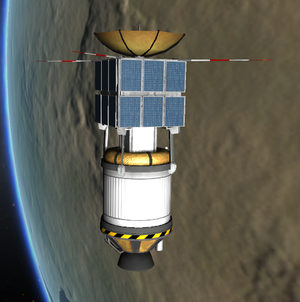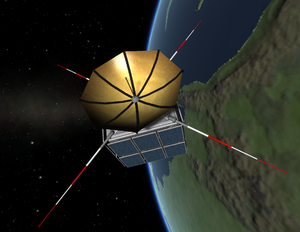Difference between revisions of "Z-MAP Satellite Launch Kit"
(→Possible uses: about the satellite itself.) |
Hairy Dude (talk | contribs) (→Capabilities: update - more useful in 1.2 with CommNet) |
||
| (12 intermediate revisions by 10 users not shown) | |||
| Line 1: | Line 1: | ||
| − | [[File:Z-MAP launch pad.png|thumb| | + | [[File:Z-MAP launch pad.png|thumb|right|upright|The '''Z-MAP Satellite Launch Kit''' and launcher on the [[launch pad]]]] |
[[File:Z-MAP 2nd stage and payload.png|thumb|The second stage and satellite on an orbit around [[Kerbin]]]] | [[File:Z-MAP 2nd stage and payload.png|thumb|The second stage and satellite on an orbit around [[Kerbin]]]] | ||
The '''Z-MAP Satellite Launch Kit''' (prior to 0.21 '''Z-MAP Satellite''') is a [[Stock craft|stock rocket]] capable of bringing a small communication satellite into orbit. It consists of four stages with the last stage as the payload. The complete craft has a mass of 20.98 t with 78 parts, including two [[TT18-A Launch Stability Enhancer]]s. | The '''Z-MAP Satellite Launch Kit''' (prior to 0.21 '''Z-MAP Satellite''') is a [[Stock craft|stock rocket]] capable of bringing a small communication satellite into orbit. It consists of four stages with the last stage as the payload. The complete craft has a mass of 20.98 t with 78 parts, including two [[TT18-A Launch Stability Enhancer]]s. | ||
| + | |||
| + | == Craft Description == | ||
| + | {{Quote|The Z-Map Satellite kit is a complete spacecraft capable of actually putting its payload into orbit!<br />Set includes: Payload satellite with booster stage, Liquid-fueled fin-stabilized launcher and two detachable boosters.<br />Return from orbit not guaranteed. Orbit also not guaranteed. Survival also not guaranteed. Keep out of reach of children and irresponsible adults.|Squad}} | ||
== Launcher == | == Launcher == | ||
| − | The launcher has a very high [[thrust-to-weight ratio]] of 3. | + | The launcher has a very high [[thrust-to-weight ratio]] of 3.1 with all three engines running at 100% throttle. Because of the high acceleration the terminal velocity is exceeded very fast lowering the efficiency. Another staging order would use only the [[RT-10 Solid Fuel Booster|booster]] until they run out after 29 seconds and switching to the [[liquid fuel engine]] then, but the TWR will drop significantly. With the addition of [[Tweakable|tweakables]] in {{version|0.23}}, the thrust of the SRBs can be reduced before launch in the VAB, and doing so will increase the efficiency even more without changing the staging or turning off the middle [[LV-T45 Liquid Fuel Engine|LV-T45]]. |
| − | Usually it is possible to reach orbit with the boosters and the first stage. To avoid debris the first stage should be | + | Usually it is possible to reach orbit with the boosters and the first stage. To avoid debris, the first stage should be shut off before reaching orbit, and the second stage should be used to achieve orbit. This stage has also its own [[Probodobodyne QBE]] command module, allowing it to deorbit itself after placing the payload in the targeted orbit. The launcher is also capable of bringing the satellite into a [[synchronous orbit]] around [[Kerbin]] and then deorbiting the second stage back to Kerbin. |
| − | The launcher | + | The launcher itself appears to be loosely based off of the [[w:Augmented Satellite Launch Vehicle|Augmented Satellite Launch Vehicle]] used by the [[w:Indian Space Research Organisation|ISRO]]. |
== Satellite == | == Satellite == | ||
| Line 15: | Line 18: | ||
The payload is a small 1.84 t heavy cubic communication satellite. It has four [[Communotron 16]] on each corner of the front surface and one [[Communotron 88-88]] placed directly on it. On each side except front and aft are six [[OX-STAT Photovoltaic Panels]] mounted. In the cube, on the other side of the Communotron 88-88, are the [[Probodobodyne OKTO2]] command module, [[Oscar-B Fuel Tank]] and [[LV-1 Liquid Fuel Engine]]. To support the structure on each corner are four [[Cubic Octagonal Strut]]s stacked on each other. | The payload is a small 1.84 t heavy cubic communication satellite. It has four [[Communotron 16]] on each corner of the front surface and one [[Communotron 88-88]] placed directly on it. On each side except front and aft are six [[OX-STAT Photovoltaic Panels]] mounted. In the cube, on the other side of the Communotron 88-88, are the [[Probodobodyne OKTO2]] command module, [[Oscar-B Fuel Tank]] and [[LV-1 Liquid Fuel Engine]]. To support the structure on each corner are four [[Cubic Octagonal Strut]]s stacked on each other. | ||
| − | As there is a battery missing the only electronic storage are the 5 | + | As there is a battery missing the only electronic storage are the 5 {{mark|echu}} in the command module, which isn't enough to operate the satellite in Kerbin's shadow. |
== Specifications == | == Specifications == | ||
| Line 44: | Line 47: | ||
|- | |- | ||
| Burn time (s) | | Burn time (s) | ||
| − | | | + | | 27.4 <ref group="Note" name="as" /> |
| − | | 125.6 | + | | 125.6 <ref group="Note" name="as" /> <!-- Per Kerbal Engineer 1.0.18.0 in KSP 1.0.4 --> |
| − | | | + | | 62.6 <!-- Per Kerbal Engineer 1.0.18.0 in KSP 1.0.4 --> |
| − | | | + | | 98.3 <!-- Per Kerbal Engineer 1.0.18.0 in KSP 1.0.4 --> |
|} | |} | ||
| − | {{Stages table notes| | + | {{Stages table notes|1}} |
| + | |||
| + | == Capabilities == | ||
| + | |||
| + | The stock Launch Kit and satellite have 5.45 km/s of [[delta-V]] -- enough to place the satellite in orbit around any planet or moon in the [[Kerbin]], [[Eve]], or [[Duna]] systems, or fly by [[Moho]] or [[Jool]] (but not quite [[Eeloo]]). This is marginally improved to 5.49 km/s by burning the solid rocket boosters on their own before igniting the LV-T45, but keeping the LV-T45 in the first stage allows the rocket to maintain a more consistent [[thrust-to-weight ratio]] and benefit from [[thrust vectoring]] throughout the launch, which may allow better efficiency in the atmosphere. | ||
| − | + | The satellite itself may be useful as a communication relay for science or control if [[CommNet]] (or a radio range mod such as RemoteTech) is being used. Without these, antennae are only useful for transmitting science, but there are no experiments on board. | |
| − | The satellite itself | ||
| − | The launcher can bring other | + | The launcher can bring other payloads into a Kerbin orbit, like the [[Ion-Powered Space Probe]]. As the thrust-to-weight ratio is very high it is also possible to bring heavier payloads in a low orbit. If we take the launcher itself to be the [[TR-2V]] decoupler and everything below (easily done with the [[sub-assemblies]] feature added in {{Version|0.22}}), the launcher can get 3.7 tons into orbit. |
| + | {{Stock craft}} | ||
[[Category:Stock craft]] | [[Category:Stock craft]] | ||
Latest revision as of 03:06, 11 July 2017


The Z-MAP Satellite Launch Kit (prior to 0.21 Z-MAP Satellite) is a stock rocket capable of bringing a small communication satellite into orbit. It consists of four stages with the last stage as the payload. The complete craft has a mass of 20.98 t with 78 parts, including two TT18-A Launch Stability Enhancers.
Craft Description
| “ | The Z-Map Satellite kit is a complete spacecraft capable of actually putting its payload into orbit! Set includes: Payload satellite with booster stage, Liquid-fueled fin-stabilized launcher and two detachable boosters. Return from orbit not guaranteed. Orbit also not guaranteed. Survival also not guaranteed. Keep out of reach of children and irresponsible adults. — Squad |
” |
Launcher
The launcher has a very high thrust-to-weight ratio of 3.1 with all three engines running at 100% throttle. Because of the high acceleration the terminal velocity is exceeded very fast lowering the efficiency. Another staging order would use only the booster until they run out after 29 seconds and switching to the liquid fuel engine then, but the TWR will drop significantly. With the addition of tweakables in version 0.23, the thrust of the SRBs can be reduced before launch in the VAB, and doing so will increase the efficiency even more without changing the staging or turning off the middle LV-T45.
Usually it is possible to reach orbit with the boosters and the first stage. To avoid debris, the first stage should be shut off before reaching orbit, and the second stage should be used to achieve orbit. This stage has also its own Probodobodyne QBE command module, allowing it to deorbit itself after placing the payload in the targeted orbit. The launcher is also capable of bringing the satellite into a synchronous orbit around Kerbin and then deorbiting the second stage back to Kerbin.
The launcher itself appears to be loosely based off of the Augmented Satellite Launch Vehicle used by the ISRO.
Satellite
The payload is a small 1.84 t heavy cubic communication satellite. It has four Communotron 16 on each corner of the front surface and one Communotron 88-88 placed directly on it. On each side except front and aft are six OX-STAT Photovoltaic Panels mounted. In the cube, on the other side of the Communotron 88-88, are the Probodobodyne OKTO2 command module, Oscar-B Fuel Tank and LV-1 Liquid Fuel Engine. To support the structure on each corner are four Cubic Octagonal Struts stacked on each other.
As there is a battery missing the only electronic storage are the 5 ⚡ in the command module, which isn't enough to operate the satellite in Kerbin's shadow.
Specifications
| 2× Booster | Stage 1 | Stage 2 | Stage 3 (Payload) | |
|---|---|---|---|---|
| Engine | RT-10 Solid Fuel Booster | LV-T45 Liquid Fuel Engine | LV-909 Liquid Fuel Engine | LV-1 Liquid Fuel Engine |
| Diameter | Small | Small | Small | Small |
| Mass (t) | 3.80 | 10.63 | 1.86 | 0.70 |
| Burn time (s) | 27.4 [Note 1] | 125.6 [Note 1] | 62.6 | 98.3 |
Capabilities
The stock Launch Kit and satellite have 5.45 km/s of delta-V -- enough to place the satellite in orbit around any planet or moon in the Kerbin, Eve, or Duna systems, or fly by Moho or Jool (but not quite Eeloo). This is marginally improved to 5.49 km/s by burning the solid rocket boosters on their own before igniting the LV-T45, but keeping the LV-T45 in the first stage allows the rocket to maintain a more consistent thrust-to-weight ratio and benefit from thrust vectoring throughout the launch, which may allow better efficiency in the atmosphere.
The satellite itself may be useful as a communication relay for science or control if CommNet (or a radio range mod such as RemoteTech) is being used. Without these, antennae are only useful for transmitting science, but there are no experiments on board.
The launcher can bring other payloads into a Kerbin orbit, like the Ion-Powered Space Probe. As the thrust-to-weight ratio is very high it is also possible to bring heavier payloads in a low orbit. If we take the launcher itself to be the TR-2V decoupler and everything below (easily done with the sub-assemblies feature added in version 0.22), the launcher can get 3.7 tons into orbit.
